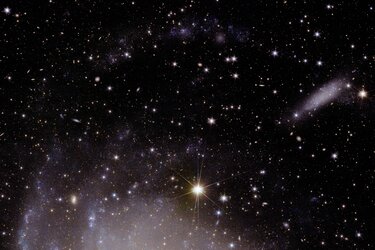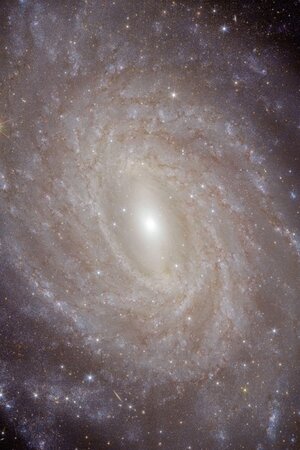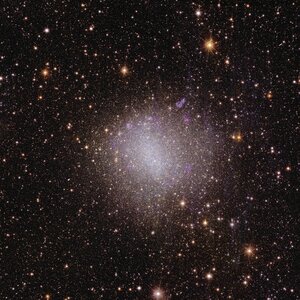
Euclid’s new image of spiral galaxy NGC 6744
This image is released as part of the Early Release Observations from ESA’s Euclid space mission. All data from these initial observations are made public on 23 May 2024– including a handful of unprecedented new views of the nearby Universe, this being one.
Here, Euclid captures NGC 6744, one of the largest spiral galaxies beyond our local patch of space. It’s a typical example of the type of galaxy currently forming most of the stars in the nearby Universe, making it a wonderful archetype to study with Euclid.
Euclid’s large field-of-view covers the entire galaxy, revealing not only spiral structure on larger scales but also capturing exquisite detail on small spatial scales, and at a combination of wavelengths. This detail includes feather-like lanes of dust emerging as ‘spurs’ from the spiral arms, which Euclid is able to image with incredible clarity. Euclid’s observations will allow scientists to not only count individual stars within NGC 6744 but also trace the wider distribution of stars and dust in the galaxy, as well as mapping the dust associated with the gas that fuels new star formation. Forming stars is the main way by which galaxies grow and evolve, so these investigations are central to understanding galaxy evolution – and why our Universe looks the way it does today.
Euclid scientists are using this dataset to understand how dust and gas are linked to star formation; map how different stellar populations are distributed throughout galaxies and where stars are currently forming; and unravel the physics behind the structure of spiral galaxies, something that’s still not fully understood after decades of study. Spiral structure is important in galaxies, as spiral arms move and compress gas to foster star formation (most of which occurs along these arms). However, the exact role of spirals in coordinating ongoing star formation remains unclear. As the aforementioned ‘spurs’ along NGC 6744’s arms are only able to form in a strong enough spiral, these features therefore provide important clues as to why galaxies look and behave as they do.
The dataset will also allow scientists to identify clusters of old stars (globular clusters) and hunt for new dwarf galaxies around NGC 6744. In fact, Euclid has already found a new dwarf ‘satellite galaxy’ of NGC 6744 – a surprise given that this galaxy has been intensively studied in the past.
NGC 6744 lies 30 million light-years away in the constellation of Pavo.
Read more about the new data released as part of Euclid’s Early Release Observations, including a stunning set of five never-before-seen images: here
Explore this image in ESASky.
Explore this image at the highest resolution in ESASky.
[Technical details: The data in this image were taken in just about one hour of observation. This colour image was obtained by combining VIS data and NISP photometry in Y and H bands; its size is 8200 x 8200 pixels. VIS and NISP enable observing astronomical sources in four different wavelength ranges. Aesthetics choices led to the selection of three out of these four bands to be cast onto the traditional Red-Green-Blue colour channels used to represent images on our digital screens (RGB). The blue, green, red channels capture the Universe seen by Euclid around the wavelength 0.7, 1.1, and 1.7 micron respectively. This gives Euclid a distinctive colour palette: hot stars have a white-blue hue, excited hydrogen gas appears in the blue channel, and regions rich in dust and molecular gas have a clear red hue. Distant redshifted background galaxies appear very red. In the image, the stars have six prominent spikes due to how light interacts with the optical system of the telescope in the process of diffraction. Another signature of Euclid special optics is the presence of a few, very faint and small round regions of a fuzzy blue colour. These are normal artefacts of complex optical systems, so-called ‘optical ghost’; easily identifiable during data analysis, they do not cause any problem for the science goals.]
[Image description: A spiral galaxy against a dark background speckled with bright dots. The clockwise spiral has many arms, not fully distinguishable from one another, extending out from a bright central spot. There is a thin cloudy structure right above the galaxy, in the outskirts of its furthest reaching arm. In the bottom left of the image two bright dots are surrounded by a halo of light.]














 Germany
Germany
 Austria
Austria
 Belgium
Belgium
 Denmark
Denmark
 Spain
Spain
 Estonia
Estonia
 Finland
Finland
 France
France
 Greece
Greece
 Hungary
Hungary
 Ireland
Ireland
 Italy
Italy
 Luxembourg
Luxembourg
 Norway
Norway
 The Netherlands
The Netherlands
 Poland
Poland
 Portugal
Portugal
 Czechia
Czechia
 Romania
Romania
 United Kingdom
United Kingdom
 Slovenia
Slovenia
 Sweden
Sweden
 Switzerland
Switzerland































